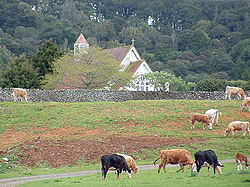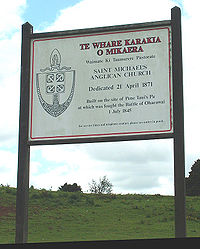
Battle of Ohaeawai
Encyclopedia


Flagstaff War
The Flagstaff War – also known as Hone Heke's Rebellion, the Northern War and erroneously as the First Māori War – was fought between 11 March 1845 and 11 January 1846 in and around the Bay of Islands, New Zealand...
in July 1845 at Ohaeawai
Ohaeawai
Ohaeawai is a small village at the junction of State Highway 1 and State Highway 12 in the Far North District of New Zealand, some 250 km from Auckland. Nearby is the site of the bloody Battle of Ohaeawai fought at Pene Taui's pā during the Flagstaff War in 1845...
in the North Island
North Island
The North Island is one of the two main islands of New Zealand, separated from the much less populous South Island by Cook Strait. The island is in area, making it the world's 14th-largest island...
of New Zealand
New Zealand
New Zealand is an island country in the south-western Pacific Ocean comprising two main landmasses and numerous smaller islands. The country is situated some east of Australia across the Tasman Sea, and roughly south of the Pacific island nations of New Caledonia, Fiji, and Tonga...
. The battle was notable in that it established that the fortified Pa
Pa (Maori)
The word pā can refer to any Māori village or settlement, but in traditional use it referred to hillforts fortified with palisades and defensive terraces and also to fortified villages. They first came into being about 1450. They are located mainly in the North Island north of lake Taupo...
could withstand bombardment from cannon fire and that frontal assaults by soldiers would result in serious troop losses.
Kawiti's success at Ohaeawai Pā
In the winter months of 1845 Lieutenant Colonel Despard led a combined force of troops from the 58th and 99th Regiments, naval marines and Māori allies in an attack on Pene Taui's PaPa (Maori)
The word pā can refer to any Māori village or settlement, but in traditional use it referred to hillforts fortified with palisades and defensive terraces and also to fortified villages. They first came into being about 1450. They are located mainly in the North Island north of lake Taupo...
(stockade) at Ohaeawai, which had been fortifed by Te Ruki Kawiti, a prominent rangatira (chief) and military leader. After a desultory bombardment the British commander, Lieutenant Colonel Despard, grew impatient and ordered a frontal assault. Over a third of his force was quickly killed or injured. Māori who fought with the British were not impressed.
The British troops arrived before the Ohaeawai Pā on 23 June and established a camp about 500 metres away. On the summit of a nearby hill (Puketapu) they built a four gun battery. They opened fire next day and continued until dark but did very little damage to the palisade. The next day the guns were brought to within 200 yards of the pā. The bombardment continued for another two days but still did very little damage. Partly this was due to the elasticity of the flax covering the palisade but the main fault was a failure to concentrate the cannon fire on one area of the defences.
After two days of bombardment without effecting a breach, Despard ordered a frontal assault. He was, with difficulty, persuaded to postpone this pending the arrival of a 32 pound naval gun which came the next day, 1 July. However an unexpected sortie from the pā resulted in the temporary occupation of the knoll on which Tāmati Wāka Nene
Tamati Waka Nene
Tāmati Wāka Nene was a Māori rangatira who fought as an ally of the British in the Flagstaff War.-Origin and mana:...
had his camp and the capture of Nene's colours - the Union Jack. The Union Jack was carried into the pā. There it was hoisted, upside down, and at half-mast high, below the Māori flag. This insulting display of the Union Jack was the cause of the disaster which ensued. Infuriated by the insult to the Union Jack Colonel Despard ordered an assault upon the pā the same day. The attack was directed to the section of the pā where the angle of the palisade allowed a double flank from which they could fire at the attackers; the attack was a reckless endeavour. The British persisted in their attempts to storm the unbreached palisades and five to seven minutes later 33 were dead and 66 injured.
Shaken by the loss of a third of this troops, Despard decided to abandon the siege. However, his Māori allies contested this decision. Tāmati Wāka Nene
Tamati Waka Nene
Tāmati Wāka Nene was a Māori rangatira who fought as an ally of the British in the Flagstaff War.-Origin and mana:...
persuaded Despard to wait for a few more days. More ammunition and supplies were brought in and the shelling continued. On the morning of 8 July the pā was found to have been abandoned, the occupants having disappeared in the night. When they had a chance to examine it the British officers found it to be even stronger than they had feared.
The drawing by Mr Symonds of the 99th Regiment describes Ohaeawai’s inner palisade as being 3 metres high, built using puriri logs. In front of the inner palisade was a ditch in which the warriors could shelter and reload their muskets then fire through gaps in the two outer palisades.
Relying on the report of her husband Henry
Henry Williams (missionary)
Henry Williams was one of the first missionaries who went to New Zealand in the first half of the 19th century....
who observed the battle, Marianne Williams
Marianne Williams
Marianne Williams together with her sister-in-law Jane Williams were pioneering educators in New Zealand. They set up the first schools for Māori children and adults as well as educating the children of the Church Missionary Society in the Bay of Islands, New Zealand...
commented on the ingenuity of the construction of the war pā:
- "It is quite astonishing how they seem to defy the British in their fortifications. They have double fences, ditches, and loop holes, their houses sunk underground; and as the great guns of the British are fired through their pa with so little loss to the rebels, it is supposed that they have large holes, in which they secure themselves. The fence round the pa is covered between every paling with loose bunches of flax, against which the bullets fall and drop; in the night they repair every hole made by the guns."
The pā was duly destroyed and the British retreated once again to the Bay of Islands
Bay of Islands
The Bay of Islands is an area in the Northland Region of the North Island of New Zealand. Located 60 km north-west of Whangarei, it is close to the northern tip of the country....
. Te Ruki Kawiti and his warriors escaped and proceeded to construct an even stronger pā at Ruapekapeka
Ruapekapeka
Ruapekapeka is a pā 14 kilometres southeast of Kawakawa in the Northland Region of New Zealand. It is one of the largest and most complex pā in New Zealand, that was designed specifically to counter the cannons of the British forces. The earthworks can still be seen just south of Kawakawa...
. The Battle of Ohaeawai was presented as a victory for the British force, notwithstanding the death of about a third of the soldiers. The reality of the end of the Battle of Ohaeawai was that Te Ruki Kawiti and his warriors had abandoned the pā in a tactical withdrawal; with the Ngāpuhi
Ngapuhi
Ngāpuhi is a Māori iwi located in the Northland region of New Zealand, and centred in the Hokianga, the Bay of Islands and Whāngārei.Ngāpuhi has the largest affiliation of any New Zealand iwi, with 122,214 people registered , and formed from 150 hapu, with 55 marae.-Foundations:The founding...
moving on to build the Ruapekapeka
Ruapekapeka
Ruapekapeka is a pā 14 kilometres southeast of Kawakawa in the Northland Region of New Zealand. It is one of the largest and most complex pā in New Zealand, that was designed specifically to counter the cannons of the British forces. The earthworks can still be seen just south of Kawakawa...
Pā from which to engage the British force on a battle field chosen by Te Ruki Kawiti.
Hone Heke
Hone Heke
Hone Wiremu Heke Pokai was a Māori rangatira and war leader in Northern New Zealand and a nephew of Hongi Hika, an earlier war leader of the Ngāpuhi iwi. Hone Heke is considered the principal instigator of the Flagstaff War....
did not participate in the Battle of Ohaeawai as he was recovering from the wounds he received at the Battle of Te Ahuahu
Te Ahuahu
Te Ahuahu is a 373 m high basaltic scoria cone, in the Kaikohe-Bay of Islands volcanic field in New Zealand.It was the site of Hone Heke's pā that was the scene of the Battle of Te Ahuahu during the Flagstaff War of 1845-46.-References:*...
.
Model for the gunfighter pa
After the battle models were made of the ingenious design of the pā, with one being went to Britain where it sat forgotten in a museum. Other Māori tribes of New Zealand became aware of the techniques used in the design of the Ohaeawai Pā in order to blunt the effectiveness of cannon and musket fire and to create firing trenches located within the inner palisade and communication trenches linking to ruas - shelters dug into the ground and covered with earth. The design of the Ohaeawai Pā, and the pā subsequently built by Kawiti at RuapekapekaRuapekapeka
Ruapekapeka is a pā 14 kilometres southeast of Kawakawa in the Northland Region of New Zealand. It is one of the largest and most complex pā in New Zealand, that was designed specifically to counter the cannons of the British forces. The earthworks can still be seen just south of Kawakawa...
, became the basis of what is now called the gunfighter pa.
Site of the battle
Cowan identifies that "the site of the Ohaeawai pa is now occupied by a Maori church and burying-ground. The scene of the battle is five miles from KaikoheKaikohe
Kaikohe is the central service area for the Far North District of New Zealand, about 260 km from Auckland, situated on State Highway 12 at...
and two miles from the Township of Ohaeawai
Ohaeawai
Ohaeawai is a small village at the junction of State Highway 1 and State Highway 12 in the Far North District of New Zealand, some 250 km from Auckland. Nearby is the site of the bloody Battle of Ohaeawai fought at Pene Taui's pā during the Flagstaff War in 1845...
. A Maori church of old-fashioned design is seen on the left as one travels from Kaikohe
Kaikohe
Kaikohe is the central service area for the Far North District of New Zealand, about 260 km from Auckland, situated on State Highway 12 at...
; it stands on a gentle rise a short distance west of the main road. The locality is usually called Ngawha
Ngawha Springs
Ngawha Springs is a small settlement approximately five kilometres east of the town of Kaikohe, Northland in New Zealand.It is the location of Ngawha Springs, a hot water spring that reputedly has therapeutic properties for those who bathe in its waters, and is the source of the steam used at the...
, from the hot springs in the neighbourhood, but it is the true Ohaeawai; the European township which has appropriated the name should properly be known as Taiamai. The church occupies the centre of the olden fortification, and a scoria-stone wall, 7 ft. high, encloses the sacred ground.".

